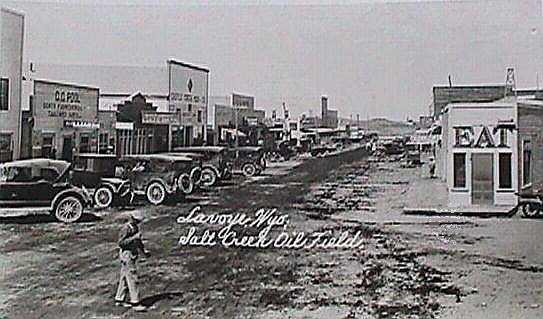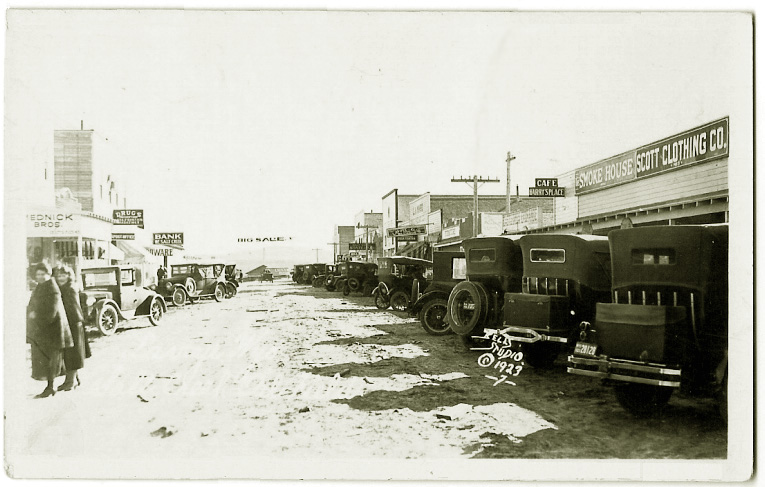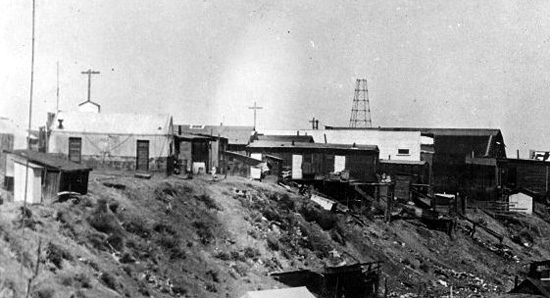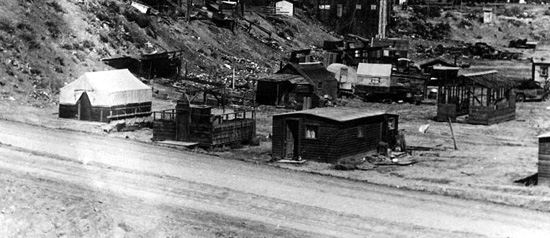
| From Wyoming Tales and Trails This page: Salt Creek Field continued, Lavoye. |
 |

| From Wyoming Tales and Trails This page: Salt Creek Field continued, Lavoye. |
 |
|
|
|
About This Site |
|
 Lavoye, Salt Creek Oil District, Wyoming, 1923 Lavoye, also known as Mosher Campp, was named after early homesteader, Louis Lavoye. Like other boom towns in Wyoming, it started as a tent city, but rapidly grew to a town with two banks, the Bank of Salt Creek at Lavoye on the right in the above photo and the Salt Creek State Bank, the Castle Creek Supply Company on the left, a Ford garage and other businesses. In 1924, the Ohio Oil Company served notices of eviction on the entire town, requiring the town to be literally moved, Ford dealership and all.
 Lavoye, Salt Creek Oil District, Wyoming, 1923 Thus, the various buildings were moved across the prairie and re-setup in the town of New Lavoye. New Lavoye, however, also did not last and is now a ghost town. Lavoye, however, was not the only town evicted by an oil company in a dispute between the surface owners and the leasees of oil rights. Such disputes are, unfortunately, all too often and the destruction of the town of Lavoye was only an exteme example.
 Lavoye, Salt Creek Oil District, Wyoming, 1923 Clarence A. Brimmer, later a United States District Judge, noted in an article, "The Rancher's Subservient Surface Estate", V Land & Water L.Rev.[Now the Wyoming Law Review] 49(1970): [Writer's notes: A "Producers 88" is not any particular pre-approved standard form. The story is that ranchers and farmers became convinced that they needed a Producers' 88 Lease as if it were some type of holy writ. Somehow there was circulated an old wives' tale that there was a pre-approved form lease agreement, fair to all, known as a "Producers 88" agreement. Farmers and ranchers began insisting that they would sign only a Producers 88 agreement. Oil Companies obliged by printing the heading "Producer's 88" on the top of a one-sided instrument which their own lawyers had drafted. The old story is that at one time there was a form lease on which a printing company had used the number 88 on the form. One Carbon County rancher signed one in which the owner of the property grants, leases and lets exclusively unto lessee for the purpose of investigating, exploring, prospecting, drilling and mining for and producing oil, gas, casinghead gas, and all other minerals (but not gravel), laying pipe lines, building tanks, power stations, telephone lines and other structures thereon to produce, save, take care of, treat, transport, and own said products, and housing its employees, [on the lands described in the lease]. See Mingo Oil Producers v. Kamp Cattle Co., 776 P. 2d 736 (Wyo. 1989). The poor rancher, however, is apt to lose in an action against the oil company, for in a reversal of language, the subsurface estate is the dominant interest and the surface interest subordinate.]
 Lavoye, Salt Creek Oil District, Wyoming, 1923 Note, the building with two doors on left in the photo is a tent with a false wooden front. But how is it that a whole town can be evicted? The similar instance of Michael F. Kieffer is instructive. In 1918, Kieffer applied to the land office in Douglas to homestead and purchase 320 acres and in due course his preliminary application was approved, he constructed a dwelling house and outbulilding upon the land. In 1923, Kieffer received his patent. Under the law, however, the United States reserved: [A] the oil and gas in the lands so patented, and to it, or persons authorized by it, the right to prospect for, mine, and remove such deposits from the same upon compliance with the conditions and subject to the provisions and limitations of the Act of July 17, 1914 (38 Stat., 509). In 1922, the Kinney-Coastal Oil Co. entered into a consolidated lease from the United States of the mineral interests over a portion of the same lands. In 1924, Kieffer platted out a town and commenced the sale of lots. As explained by the United States Supreme Court in sustaining an injunction against the town, the oil company was only seeking to preclude the surface owner from obstructing the company's enjoyment of its interest in the property. In other words, if the presence of the town interferes with the ability to drill for oil, lay the pipelines, house the riggers, etc., the town has to go. See Kinney-Coastal Oil Co. v. Kieffer, 277 U.S. 488 (1928).
 Lavoye, Salt Creek Oil District, Wyoming, 1923 The Ohio Oil Company was founded in 1887. It was acquired by the Standard Trust and upon the breakup of the Trust in 1911 again became an independent. It is now knows as Marathon Oil Company. Marathon now holds many of the Kinney-Coastal leases. Another Ohio camp, Parkerton, Wyoming, is depicted in the next photo.
 Ohio Camp, Parkerton, Converse County, Wyoming, undated Next page: McFadden. |